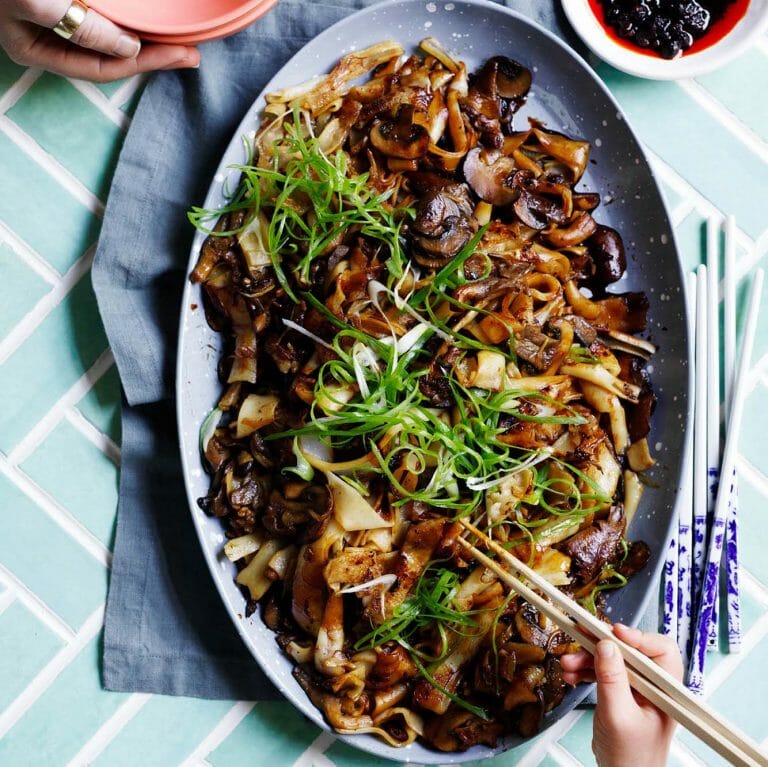
Wet-fry mushroom noodles from The Joy of Better Cooking
Servings: 4
I learned to wet-fry mushrooms on a mushroom foraging tour with Jim, a tall Texan, and Chris, a mycologist-slash-Hobbit. Chris showed us how to find even the most magic of mushrooms, while Jim explained that as mushrooms aren’t technically vegetables, they behave differently when boiled; magic happens! Rather than their cell structure breaking down or toughening up, they pretty much stay the same, absorbing whatever flavour you throw at them — or into them. That’s why I wash mushrooms with abandon now and just crank the heat up to full blast to help the extra water to Exit, pan left. For maximum flavour infusion, it pays to keep the heat high until all of the liquid in the pan evaporates, holding off adding any fat until after the mushrooms have started turning browner. You may not go the full noodle every time, but I guarantee that frying mushrooms this way will revolutionise your breakfast ’shrooms forever.
PRINT
Ingredients
- 400 g (14 oz) Swiss brown mushrooms, thinly sliced
- 6 fresh shiitake mushrooms thinly sliced (see Ingredient spotlight, page 114)
- 200 g (7 oz) shimeji or oyster mushrooms pulled apart into smaller clusters (see Ingredient spotlight, page 114)
- 1 cup (250 ml) water
- 3 tbsp neutral-flavoured oil I like grapeseed
- ¼ cup (60 ml) oyster sauce (see Subs, page 114)
- 2 tbsp dark soy sauce
- 2 red Asian shallots finely sliced
- 1 thumb-sized knob fresh ginger peeled and grated
- 2-3 garlic cloves grated
- 250 g (9 oz) fresh rice noodles (see Tips and Subs, page 114)
- 2 tbsp light soy sauce
- 1 tsp sesame oil
- 3 spring onions (scallions) finely sliced
- MYO chilli oil page 213, for a bit of extra kick (optional)
Instructions
- Plonk all of the mushrooms into your wok, or your widest pan with high sides. Add ½ cup (125 ml) water and crank the heat up to high. Bubbles are good. The amount of mushrooms will appear to reduce by half (don’t worry — they’re still there). Allow at least 10–15 minutes over high heat for the water to completely evaporate and the mushrooms to start to brown. (I know, I know … they were already brown to begin with.)
- Splash in a tablespoon of the oil to help the caramelisation along. The mushrooms will quickly start to colour, but be patient and let them caramelise for about 10 minutes over medium–high heat, stirring now and then, so all the mushrooms have a sweet little burnished edge to them.
- Splash in the oyster sauce and dark soy sauce, stirring to deglaze the pan. Pull out the mushrooms and set aside in a bowl.
- Add the shallot to the wok with another tablespoon of the oil. Fry for a minute or two, until golden, then add the ginger and garlic and sauté for a few more minutes. Tip the mixture over the mushrooms.
- Crank the heat back up under your wok. Splash in the rest of your oil, add your noodles and leave them alone for at least a minute or two, or as long as it takes to get a little char on them (try not to move them too much, as this can cause breakage).
- Splash in another ½ cup (125 ml) water and let it evaporate; the steam will break up your noodles if you think they are stuck together. Add the mushrooms and ginger mix back in and toss everything about. Splash in the light soy sauce and the sesame oil and let it sizzle for a minute. Turn the whole thing off, top with the spring onion and serve with the chilli oil, if you like it spicy.
Notes
Tips
Depending on how fresh your noodles are, they might need a little love to soften them enough so that they stay pliable. If they start crumbling into many, many sad pieces as you pull them out of the packet, try popping them into the microwave, with a splash of water in the bottom of the bowl or plate, and zapping them for 20–30 seconds to bring them back to life. Or, place the noodles in a heatproof bowl, pour a kettle of boiling water over them and stand for 3 minutes, then drain and add to the stir-fry. If your pan refuses to char the noodles without them sticking to its surface, use some baking paper as a go-between. Once the pan is hot enough, slip in the paper, pop the oiled noodles on top and let them colour without moving them about too much. You’ll find more about cooking noodles on page 82.
Subs
Try hor fun rice noodles, which you’ll find in the fridge at specialty Asian grocers. You could also use fresh cheung fun noodle pastry, which can be cut to thick noodle size. Alternatively, you can use dried flat rice noodles, which will need to be softened in boiling water according to the packet instructions first. Go for a minute or so less than they suggest, as the noodles will get a quick cook-up in the pan. Oyster sauce is one of my go-to splashes when stir-frying veg as it adds such a sweet, savoury boost. It’s also fab for marinades, especially if you’re a chicken-wing roaster. If you don’t have oyster sauce, use extra soy sauce and an extra sprinkling of sugar and/or honey.